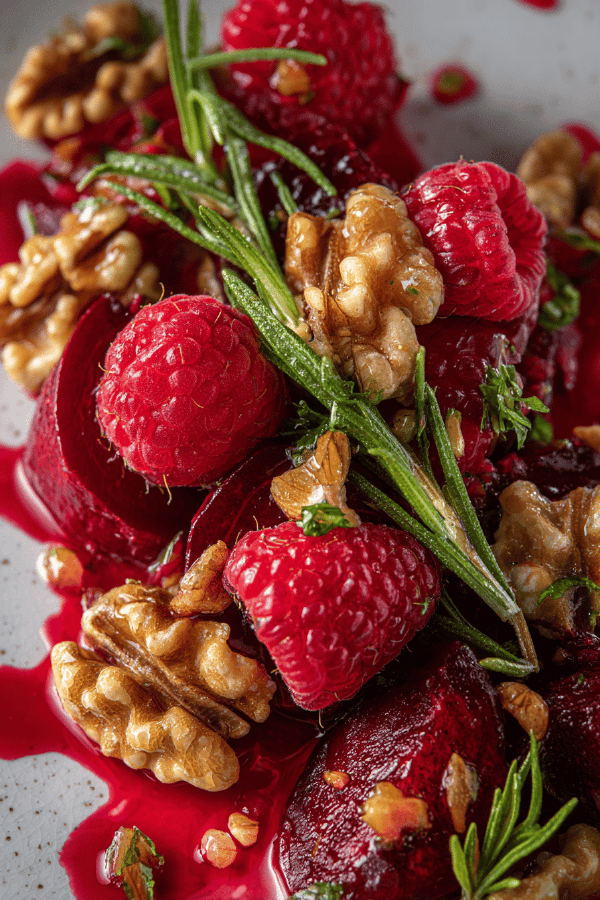Featured Recipe
Beets Pickled with Raspberry Twist

By Kate
"
Roast whole beets until tender, peel and slice thin. Simmer fresh raspberries with white wine vinegar and honey to make a tangy syrup, strain out seeds. Toss beets with syrup and toasted walnut oil. Season simply. Serve warm or chilled, a mix of earthy sweetness and bright acidity. No slow cooker needed. Substitutes include apple cider vinegar for tartness, or hazelnut oil for nuttiness. Visual cues guide the roasting and syrup making instead of strict clocks. Rustle in kitchen sounds, aromas of roasting, simmering fruit, hint real kitchen work underway.
"
Prep:
15 min
Cook:
50 min
Total:
65 min
Serves:
6 servings
beets
pickling
salads
sides
Introduction
Not your usual pickled beets. Roasting brings out smoky earth notes; raspberries add a sharp twist in sweet-tart balance. Ditch the slow cooker. Oven roasting gives more control; texture holds better, flavor concentrates with caramelized edges. No crushing fruit too early or syrup loses brightness—strain well. Oil is more than slick; toasted nut oils add aromatic depth, complexity. Everything is about layering flavors and textures with patience and sensory cues. Watch and smell and test, not just time. Sweet, tart, earthy, oily; each bite tells a story. Skip the fuss but keep the character. Works as cold salad side or warm partner. Practical swaps included for real kitchens. Play with acidity and toast of oil to make it yours.
Ingredients
About the ingredients
Scaling back beets from 6 to 4 reduces total bulk—don’t skimp on raspberries; they’re flavor drivers here. Fresh raspberries deliver brighter aroma, but frozen can stand in if drained well. Replace balsamic with white wine vinegar for lighter acidity, or champagne vinegar for subtle fruitiness. Using honey instead of sugar adds richer sweetness and depth, avoids harsh crystallization in syrup. Toasted walnut oil introduces nutty notes; substitute with hazelnut or grapeseed oil if allergies or availability issues. Salt counterbalances sweet syrup, so season gradually. Always measure vinegar carefully; too much kills balance. Peel roasting keeps flesh intact, avoids waterlogged slices. Handling beets gently avoids bruising and color loss. Raw beet handling with gloves recommended if staining is a concern.
Method
Technique Tips
Roast wrapped beets—not boiling or slow cooker—to control texture and flavor intensity. Test doneness visually and with skewer to catch just tender beets; too soft means mushy slices. Wrapping locks in moisture, steams cooked flesh, assists peeling without losing flavor. Simmer raspberry syrup gently; rapid high boil risks burning honey and losing fresh raspberry notes. Straining is essential; seeds add bitterness and texture mismatch. Toss beets warm with syrup and oil so oils emulsify slightly, coating wedges. Adjust seasoning after tasting, acidity balances sweetness; too little vinegar makes syrup cloying. Rest at least 10 minutes to let flavors marry; longer for deeper notes. Serve warm or chilled; texture shifts slightly but flavor stands. Use fresh herbs to add freshness. Twist: a drop of smoked paprika stirred in for subtle earth. Real kitchens adapt timing and texture by feel, sight, smell; trust senses over clocks.
Chef's Notes
- 💡 Roasting beets works better than boiling. Wrapping keeps moisture, retain earthy flavors. Test with skewer, should be softened, not mushy. Use kitchen sounds. Smell as they get close to done.
- 💡 Fresh raspberries give a sharper taste; frozen works too, just drain excess. Swapping honey for sugar enriches syrup, better flavor. Adjust sweetness along the way. Avoid cloying textures.
- 💡 Use apple cider or champagne vinegar if white wine isn't handy; mild acidity matters. Experiment with oils—hazelnut for nuttiness. Always taste as you go, balance is key.
- 💡 If the syrup's too thin, keep simmering to thicken slowly. Burning reduces brightness. Strain out seeds well. Those tiny bits can spoil tasting experience—not the best.
- 💡 Prevent color loss while peeling with gloves if worried about stains; handling beets carefully saves flavor, texture. Thick wedges hold up better. Rest the dish to let flavors blend.
Kitchen Wisdom
What if my beets turn mushy?
Overcooked beets lose their texture. Use skewer test. Should be tender, not falling apart. Wrap tightly to control steam.
Can I substitute the raspberries?
Yes, any similar fruit can work. Blackberries might do, but taste shifts. Frozen raspberries acceptable, thaw and drain well.
How to store the leftovers?
Keep in airtight container; refrigerate up to three days. Flavors meld. Can serve chilled or warm. Reheat gently to maintain texture.
Need options for avoiding honey?
Maple syrup can replace honey; different sweetness but rich. Brown sugar works too; melt with water for syrup. Vary acidity if sweetness changes.



